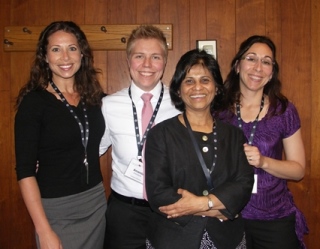Students’ Group Work Affected by Gender Composition
August 26, 2013

Julia Rutledge, Amanda Evenstone, Dr. Sadhana Puntambekar, Dana Gnesdilow
Students may learn more in mixed-gender groups than when they work solely with members of their own gender, a study by a group of WCER researchers, led by Sadhana Puntambekar , has found.
Preliminary results of data collected through Puntambekar’s CoMPASS project show that middle school science students working in groups containing at least one member of the opposite gender scored significantly higher than single-sex groups on a test covering the content the groups studied, according to a paper co-authored by Dana Gnesdilow, Amanda Evenstone, Julia Rutledge, Sarah Sullivan, and Puntambekar.
The CoMPASS project has been developed over the past 10 years with the intent of studying how digital resources can be integrated in inquiry-based science classes. Puntambekar’s students discovered the results while reviewing the massive trove of data gathered during the course of the study in advance of the 2013 Computer Supported Collaborative Learning Conference, which took place in the University of Wisconsin-Madison’s Memorial Union from June 15 to 19.
The researchers presented their paper, “Group Work in the Science Classroom: How Gender Composition May Affect Individual Performance,” at the conference, which is organized biennially by the International Society of the Learning Sciences to investigate aspects of technology-based collaborative learning including research, education, training and technology.
The study looked at 637 students in sixth, seventh, and eighth grades, enrolled in three different school districts, who were split up into 178 groups of either three or four students each. The student groups worked together for 12 weeks on a project studying forces of motion and energy, which culminated in each group constructing a roller coaster engineering design proposal. All participants took pre- and post-tests, and results from the assessments showed mixed-gender groups outperformed all-male and all-female groups.
“Preliminary results suggest having one member of the opposite gender does significantly improve the scores of students working in groups,” Evenstone said during the group’s presentation. “It may help show that a student’s learning outcome may be better explained by his or her group’s gender composition rather than the genders of individual group members.”
According to Gnesdilow, the findings could have significant impact if proven true on a larger scale, as it is one of the first studies to state that individual learning outcomes may be influenced by the gender composition of the group that a student is working in. Since controlling for gender in group work is an aspect of classroom dynamics that teachers can easily control, it could be an easily implementable method to improve student learning, Gnesdilow said.
“We certainly don’t want to overstate these results, especially as this topic is generally under-researched and existing findings are conflicting,” Gnesdilow said. “However, our results could improve the way students are organized into groups for collaborative learning – a factor that’s easily controlled by the teacher.”
Rutledge said her research group was not finished reviewing the CoMPASS data for qualitative results that might provide greater insight into the initial results.
“We’re interested in delving a little deeper into the data, utilizing video and audio recorded during the classes, as well as assigned writing done by the students, to try to better understand our findings,” Rutledge said.


